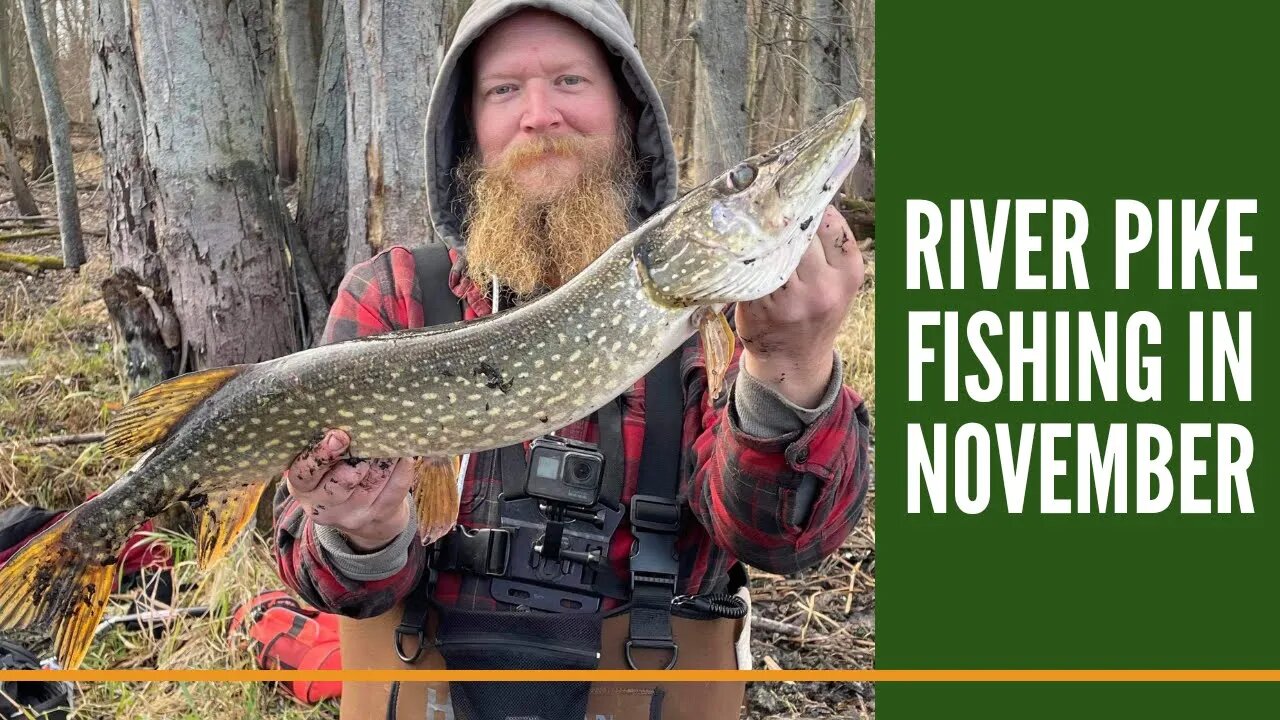Premium Only Content

River Pike Fishing / Live Bait Under A Bobber / Michigan Northern Pike Fishing
In this video I am doing some river pike fishing in November. Michigan northern pike fishing in late fall and early winter can be great and I always look forward to big winter pike come the end of fall. My favorite way to catch cold weather pike is with shiners under a bobber. I have been slacking on putting out good pike fishing videos but I made up to lost time with this Northern Pike fishing video. We caught a bunch of nice size northern pike on this trip. I showed up to fish this spot an my GoPro batteries were all mostly dead so I used my back up camera and got some cool shots. For more Michigan pike fishing videos make sure to subscribe
The northern pike (Esox lucius) is a species of carnivorous fish of the genus Esox (the pikes). They are typical of brackish and fresh waters of the Northern Hemisphere (i.e. holarctic in distribution). They are known simply as a pike in Britain, Ireland, and most of Eastern Europe, Canada and the United States.
Pike can grow to a relatively large size: the average length is about 40–55 cm (16–22 in), with maximum recorded lengths of up to 150 cm (59 in) and published weights of 28.4 kg (63 lb). The IGFA currently recognizes a 25 kg (55 lb) pike caught by Lothar Louis on Greffern Lake, Germany, on 16 October 1986, as the all-tackle world-record northern pike.
Habitat
Pike are found in sluggish streams and shallow, weedy places in lakes and reservoirs, as well as in cold, clear, rocky waters. They are typical ambush predators; they lie in wait for prey, holding perfectly still for long periods, and then exhibit remarkable acceleration as they strike. They inhabit any water body that contains fish, but suitable places for spawning are also essential. Because of their cannibalistic nature, young pike need places where they can take shelter between plants so they are not eaten. In both cases, rich submerged vegetation is needed. Pike are seldom found in brackish water, except for the Baltic Sea area, here they can be found spending time both in the mouths of rivers and in the open brackish waters of the Baltic Sea. It is normal for pike to return to fresh water after a period in these brackish waters. They seem to prefer water with less turbidity, but that is likely related to their dependence on the presence of vegetation.
Behavior
Aggression
The northern pike is a relatively aggressive species, especially with regard to feeding. For example, when food sources are scarce, cannibalism develops, starting around five weeks in a small percentage of populations. This cannibalism occurs when the ratio of predator to prey is two to one. One can expect this because when food is scarce, Northern pike fight for survival, such as turning on smaller pike to feed; this is seen in other species such as tiger salamanders. Usually, pike tend to feed on smaller fish, such as the banded killifish. However, when pike exceed 700 mm (28 in) long, they feed on larger fish.
Because of cannibalism when food is short, pike suffer a fairly high young mortality rate. Cannibalism is more prevalent in cool summers, as the upcoming pike have slow growth rates in that season and might not be able to reach a size to deter the larger pike. Cannibalism is likely to arise in low growth and low food conditions. Pike do not discriminate siblings well,[citation needed] so cannibalism between siblings is likely.
Aggression also arises from a need for space. Young pike tend to have their food stolen by larger pike. Pike are aggressive if not given enough space because they are territorial. They use a form of foraging known as ambush foraging. Unlike species such as perch, pike undergo bursts of energy instead of actively chasing down prey. As such, a fair amount of inactive time occurs until they find prey. Hunting efficiency decreases with competition; the larger the pike, the larger the area controlled by that particular pike. An inverse relation to vegetation density and pike size exists, which is due to the possibility of cannibalism from the largest pike. This makes sense, as the smaller pike need more vegetation to avoid being eaten. Large pike do not have this worry and can afford the luxury of a large line of sight. They prefer a tree structure habitat.
#pikefishingvideos
#Howtocatchnorthernpike
#MichiganNorthernPikeFishing
#tipsforfisherman
#PikefishingMichigan
#northernpikeriverfishing
#northernpikeangler
#northernpikefishingMichigan
#easyfishingtipsforbeginners
#fishing
#fishingvideos
#fish
-
 11:14
11:14
Michigan fishing videos
1 year ago $0.29 earnedMichigan Coho Salmon Fishing In The River / Float Fishing For Salmon With Skein / Coho Bobber Downs
3.82K5 -
 LIVE
LIVE
Donut Operator
43 minutes agoI'M BACK/ CRIME/ WHERE MP7
326 watching -
 LIVE
LIVE
Dr. Eric Berg
4 days agoThe Dr. Berg Show LIVE July 25, 2025
357 watching -
 LIVE
LIVE
LFA TV
13 hours agoLFA TV ALL DAY STREAM - FRIDAY 7/25/25
4,529 watching -
 1:02:20
1:02:20
VINCE
3 hours agoGhislaine Has Talked! What Did She Say? | Episode 93 - 07/25/25
147K77 -
 LIVE
LIVE
The Big Mig™
3 hours agoBiden’s Chief Of Staff Snitching On Biden To Congress
5,037 watching -
 LIVE
LIVE
Bannons War Room
5 months agoWarRoom Live
15,228 watching -
 1:14:59
1:14:59
Dear America
3 hours agoClinton Wrote a SHOCKING Birthday Letter To Epstein!! JAIL!! + Rest In Peace Hulk Hogan…
124K84 -
 LIVE
LIVE
Badlands Media
10 hours agoBadlands Daily: July 25, 2025
5,315 watching -
 LIVE
LIVE
Wendy Bell Radio
7 hours agoLet's Find The Kids
8,969 watching